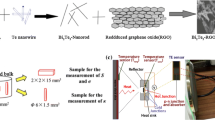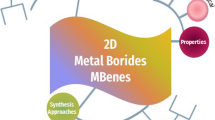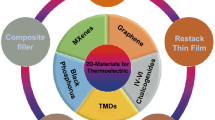Abstract
In this study, a hybrid organic–inorganic material based on polypyrrole (PPy), graphene nanoplatelets (GNPs), and bismuth oxide nanoparticles (Bi2O3) was developed to overcome the limitations of organic materials’ thermoelectric (TE) conversion efficiency. The GNPs were decorated with Bi2O3 nanoparticles using a simple and effective method based on infrared irradiation and diazonium chemistry. The synthesized nanocomposites were characterized using various techniques such as X-ray diffraction, Transmission electron microscopy, Raman spectroscopy, Fourier transform infrared spectroscopy, and X-ray photoelectron spectroscopy to examine the structural and physical properties. The results of this study showed a promising improvement in electrical conductivity (σ) and Seebeck coefficient (S) of PPy/GNPs-Bi2O3 compared to pure PPy, attributed to the π–π stacking between PPy chains and GNPs surface. Bi2O3 enhances the TE behavior of the nanocomposite by improving charge transport and binding both components (PPy and GNPs). At room temperature, the power factor was found to be 11 times higher (1 µW m−1 K−2) compared to pure PPy. Further exploration at high temperatures could result in higher TE performance.
Graphical abstract









Similar content being viewed by others
Data availability
Not applicable.
References
Molina-Lopez F (2020) Emerging thermoelectric generators based on printed and flexible electronics technology. In: 2020 IEEE SENSORS. pp 1–4
Kim HS, Liu W, Chen G et al (2015) Relationship between thermoelectric figure of merit and energy conversion efficiency. Proc Natl Acad Sci 112:8205–8210. https://doi.org/10.1073/pnas.1510231112
Snyder GJ, Snyder AH (2017) Figure of merit ZT of a thermoelectric device defined from materials properties. Energy Environ Sci 10:2280–2283. https://doi.org/10.1039/C7EE02007D
Kanahashi K, Pu J, Takenobu T (2020) 2D materials for large-area flexible thermoelectric devices. Adv Energy Mater 10:1902842. https://doi.org/10.1002/aenm.201902842
Wang T, Liu C, Wang X et al (2017) Highly enhanced thermoelectric performance of WS2 nanosheets upon embedding PEDOT:PSS. J Polym Sci Part B Polym Phys 55:997–1004. https://doi.org/10.1002/polb.24349
Liu X, Wang D, Wei P et al (2012) Effect of carrier mobility on magnetothermoelectric transport properties of graphene. Phys Rev B 86:155414. https://doi.org/10.1103/PhysRevB.86.155414
Wang D, Shi J (2011) Effect of charged impurities on the thermoelectric power of graphene near the Dirac point. Phys Rev B 83:113403. https://doi.org/10.1103/PhysRevB.83.113403
Sang M, Shin J, Kim K, Yu KJ (2019) Electronic and thermal properties of graphene and recent advances in graphene based electronics applications. Nanomaterials 9:374. https://doi.org/10.3390/nano9030374
Mardi S, Ambrogioni MR, Reale A (2020) Develo** printable thermoelectric materials based on graphene nanoplatelet/ethyl cellulose nanocomposites. Mater Res Express 7:085101. https://doi.org/10.1088/2053-1591/ababc0
Liu Z, Sun J, Song H et al (2021) High performance polypyrrole/SWCNTs composite film as a promising organic thermoelectric material. RSC Adv 11:17704–17709. https://doi.org/10.1039/D1RA02733F
Kumanek B, Stando G, Wróbel PS et al (2019) Thermoelectric properties of composite films from multi-walled carbon nanotubes and ethyl cellulose doped with heteroatoms. Synth Met 257:116190. https://doi.org/10.1016/j.synthmet.2019.116190
Zhang K, Zhang Y, Wang S (2013) Enhancing thermoelectric properties of organic composites through hierarchical nanostructures. Sci Rep 3:3448. https://doi.org/10.1038/srep03448
Piao M, Li C, Chu J et al (2018) Influence of chemical functionalization on the thermoelectric properties of monodispersed single-walled carbon nanotubes. J Mater Sci. https://doi.org/10.1007/s10853-018-2063-4
Lan X, Liu C, Wang T et al (2019) Effect of functional groups on the thermoelectric performance of carbon nanotubes. J Electron Mater 48:6978–6984. https://doi.org/10.1007/s11664-019-07519-6
Liebscher M, Gärtner T, Tzounis L et al (2014) Influence of the MWCNT surface functionalization on the thermoelectric properties of melt-mixed polycarbonate composites. Compos Sci Technol 101:133–138. https://doi.org/10.1016/j.compscitech.2014.07.009
Bourenane Cherif Y, Mekhalif Z, Mekki A, Bekkar Djelloul Sayah Z (2022) Effect of MWCNTs surface functionalization group nature on the thermoelectric power factor of PPy/MWCNTs nanocomposites. Synth Met 291:117196. https://doi.org/10.1016/j.synthmet.2022.117196
Liang L, Chen G, Guo C-Y (2017) Polypyrrole nanostructures and their thermoelectric performance. Mater Chem Front 1:380–386. https://doi.org/10.1039/C6QM00061D
Zhu Z, Wang L, Gao C (2022) Chapter 3 - Thermoelectric properties of PEDOTs. In: Jiang F, Liu C, Xu J (eds) Advanced PEDOT thermoelectric materials. Woodhead Publishing, Cambridge, pp 73–95
Xu S, Shi X-L, Dargusch M et al (2021) Conducting polymer-based flexible thermoelectric materials and devices: from mechanisms to applications. Prog Mater Sci 121:100840. https://doi.org/10.1016/j.pmatsci.2021.100840
Cao T, Shi X-L, Chen Z-G (2023) Advances in the design and assembly of flexible thermoelectric device. Prog Mater Sci 131:101003. https://doi.org/10.1016/j.pmatsci.2022.101003
Yin S, Lu W, Wu X et al (2021) Enhancing thermoelectric performance of polyaniline/single-walled carbon nanotube composites via dimethyl sulfoxide-mediated electropolymerization. ACS Appl Mater Interfaces 13:3930–3936. https://doi.org/10.1021/acsami.0c19100
Zhang Q, Sun Y, Xu W, Zhu D (2014) Organic thermoelectric materials: emerging green energy materials converting heat to electricity directly and efficiently. Adv Mater 26:6829–6851. https://doi.org/10.1002/adma.201305371
Du Y, Shen SZ, Cai K, Casey PS (2012) Research progress on polymer–inorganic thermoelectric nanocomposite materials. Prog Polym Sci 37:820–841. https://doi.org/10.1016/j.progpolymsci.2011.11.003
Tang X, Liu T, Li H et al (2017) Notably enhanced thermoelectric properties of lamellar polypyrrole by do** with β-naphthalene sulfonic acid. RSC Adv 7:20192–20200. https://doi.org/10.1039/C7RA02302B
Du Y, Niu H, Li J et al (2018) Morphologies tuning of polypyrrole and thermoelectric properties of polypyrrole nanowire/graphene composites. Polymers 10:1143. https://doi.org/10.3390/polym10101143
Baghdadi N, Zoromba MS, Abdel-Aziz MH et al (2021) One-dimensional nanocomposites based on Polypyrrole-Carbon nanotubes and their thermoelectric performance. Polymers 13:278. https://doi.org/10.3390/polym13020278
Chatterjee MJ, Chakraborty P, Banerjee D (2022) Charge transport through polypyrrole and single-walled carbon nanotube composite: a thermoelectric material. J Electron Mater 51:5956–5964. https://doi.org/10.1007/s11664-022-09812-3
Liang L, Fan J, Wang M et al (2020) Ternary thermoelectric composites of polypyrrole/PEDOT:PSS/carbon nanotube with unique layered structure prepared by one-dimensional polymer nanostructure as template. Compos Sci Technol 187:107948. https://doi.org/10.1016/j.compscitech.2019.107948
Wang Y, Yang J, Wang L et al (2017) Polypyrrole/Graphene/Polyaniline ternary nanocomposite with high thermoelectric power factor. ACS Appl Mater Interfaces 9:20124–20131. https://doi.org/10.1021/acsami.7b05357
Zheng Z-H, Shi X-L, Ao D-W et al (2022) Harvesting waste heat with flexible Bi2Te3 thermoelectric thin film. Nat Sustain. https://doi.org/10.1038/s41893-022-01003-6
Yin L-C, Liu W-D, Li M et al (2021) High carrier mobility and high figure of merit in the CuBiSe2 alloyed GeTe. Adv Energy Mater 11:2102913. https://doi.org/10.1002/aenm.202102913
Ji L (2018) 3 - Metal oxide-based thermoelectric materials. In: Wu Y (ed) Metal oxides in energy technologies. Elsevier, Heidelberg, pp 49–72
Yin Y, Tudu B, Tiwari A (2017) Recent advances in oxide thermoelectric materials and modules. Vacuum 146:356–374. https://doi.org/10.1016/j.vacuum.2017.04.015
Feng Y, Jiang X, Ghafari E et al (2018) Metal oxides for thermoelectric power generation and beyond. Adv Compos Hybrid Mater 1:114–126. https://doi.org/10.1007/s42114-017-0011-4
Eom J-H, Jung H-J, Han J-H et al (2014) Formation of Bismuth Nanocrystals in Bi2O3 thin films grown at 300 K by pulsed laser deposition for thermoelectric applications. ECS J Solid State Sci Technol 3:P315. https://doi.org/10.1149/2.0101410jss
Debnath A, Deb K, Bhowmik KL, Saha B (2020) Reduced hop** barrier potential in NiO Nanoparticle-Incorporated, Polypyrrole-Coated graphene with enhanced thermoelectric properties. ACS Appl Energy Mater 3:7772–7781. https://doi.org/10.1021/acsaem.0c01174
Martis P, Venugopal BR, Seffer J-F et al (2011) Infrared irradiation controlled decoration of multiwalled carbon nanotubes with copper/copper oxide nanocrystals. Acta Mater 59:5040–5047. https://doi.org/10.1016/j.actamat.2011.04.061
Bekkar Djelloul Sayah Z, Mekki A, Delaleux F et al (2019) Response surface methodology as a powerful tool for the synthesis of polypyrrole-doped organic sulfonic acid and the optimization of its thermoelectric properties. J Electron Mater 48:3662–3675. https://doi.org/10.1007/s11664-019-07124-7
Albetran HM (2020) Structural characterization of graphite nanoplatelets synthesized from graphite flakes. Preprints, 2020080325. https://doi.org/10.20944/preprints202008.0325.v1
Ward MR, Younis S, Cruz-Cabeza AJ et al (2019) Discovery and recovery of delta p-aminobenzoic acid. CrystEngComm 21:2058–2066. https://doi.org/10.1039/C8CE01882K
Karuppasamy P, Kamalesh T, Mohankumar V et al (2019) Synthesis, growth, structural, optical, thermal, laser damage threshold and computational perspectives of 4-nitrophenol 4-aminobenzoic acid monohydrate (4NPABA) single crystal. J Mol Struct 1176:254–265. https://doi.org/10.1016/j.molstruc.2018.08.074
Bhakta AK, Detriche S, Kumari S et al (2018) Multi-wall carbon nanotubes decorated with Bismuth Oxide Nanocrystals using infrared irradiation and diazonium chemistry. J Inorg Organomet Polym Mater 28:1402–1413. https://doi.org/10.1007/s10904-018-0800-4
Li M, Zhang Y, Yang L et al (2015) Excellent electrochemical performance of homogeneous polypyrrole/graphene composites as electrode material for supercapacitors. J Mater Sci Mater Electron 26:485–492. https://doi.org/10.1007/s10854-014-2425-x
Zerbi G, Castiglioni C, Lopez Navarrete JT et al (1989) A molecular viewpoint of lattice dynamics and spectra of conducting polymers. Synth Met 28:D359–D368. https://doi.org/10.1016/0379-6779(89)90715-7
Šetka M, Calavia R, Vojkůvka L et al (2019) Raman and XPS studies of ammonia sensitive polypyrrole nanorods and nanoparticles. Sci Rep 9:8465. https://doi.org/10.1038/s41598-019-44900-1
Bhakta AK, Detriche S, Martis P, Mascarenhas RJ, Delhalle J, Mekhalif Z (2017) Decoration of tricarboxylic and monocarboxylic aryl diazonium functionalized multi-wall carbon nanotubes with iron nanoparticles. J Mater Sci 52:9648–9660. https://doi.org/10.1007/s10853-017-1100-z
Alatawna A, Birenboim M, Nadiv R et al (2020) The effect of compatibility and dimensionality of carbon nanofillers on cement composites. Constr Build Mater 232:117141. https://doi.org/10.1016/j.conbuildmat.2019.117141
Bhakta AK, Kumari S, Hussain S et al (2019) Differently substituted aniline functionalized MWCNTs to anchor oxides of Bi and Ni nanoparticles. J Nanostruct Chem 9:299–314. https://doi.org/10.1007/s40097-019-00319-8
Cao J, Wang Y, Chen J et al (2015) Three-dimensional graphene oxide/polypyrrole composite electrodes fabricated by one-step electrodeposition for high performance supercapacitors. J Mater Chem A 3:14445–14457. https://doi.org/10.1039/C5TA02920A
Gence L, Faniel S, Gustin C et al (2007) Structural and electrical characterization of hybrid metal-polypyrrole nanowires. Phys Rev B 76:115415. https://doi.org/10.1103/PhysRevB.76.115415
Sreeprasad TS, Berry V (2013) How do the electrical properties of graphene change with its functionalization? Small 9:341–350. https://doi.org/10.1002/smll.201202196
Wang L, Liu F, ** C et al (2014) Preparation of polypyrrole/graphene nanosheets composites with enhanced thermoelectric properties. RSC Adv 4:46187–46193. https://doi.org/10.1039/C4RA07774A
Zhang Y, Zhang Q, Chen G (2020) Carbon and carbon composites for thermoelectric applications. Carbon Energy 2:408–436. https://doi.org/10.1002/cey2.68
Alsalama M, Hamoudi H, Youssef KM (2021) The effect of graphene structural integrity on the power factor of tin selenide nanocomposite. J Alloys Compd 872:159584. https://doi.org/10.1016/j.jallcom.2021.159584
Shin WH, Ahn K, Jeong M et al (2017) Enhanced thermoelectric performance of reduced graphene oxide incorporated bismuth-antimony-telluride by lattice thermal conductivity reduction. J Alloys Compd 718:342–348. https://doi.org/10.1016/j.jallcom.2017.05.204
Debnath A, Deb K, Sarkar K, Saha B (2021) Low interfacial energy barrier and improved thermoelectric performance in Te-Incorporated Polypyrrole. J Phys Chem C 125:168–177. https://doi.org/10.1021/acs.jpcc.0c09100
Acknowledgements
Younes Bourenane Cherif acknowledges Ecole Militaire Polytechnique d’Alger, Algeria, for his Ph.D. grant.
Author information
Authors and Affiliations
Corresponding author
Ethics declarations
Conflict of interest
The authors declare that they have no conflict of interest.
Additional information
Handling Editor: Kyle Brinkman.
Publisher's Note
Springer Nature remains neutral with regard to jurisdictional claims in published maps and institutional affiliations.
Rights and permissions
Springer Nature or its licensor (e.g. a society or other partner) holds exclusive rights to this article under a publishing agreement with the author(s) or other rightsholder(s); author self-archiving of the accepted manuscript version of this article is solely governed by the terms of such publishing agreement and applicable law.
About this article
Cite this article
Bourenane Cherif, Y., Mekhalif, Z., Mekki, A. et al. Enhanced thermoelectric power factor of PPy-based nanocomposites: effect of decorated graphene nanoplatelets by bismuth oxide nanoparticles. J Mater Sci 58, 4809–4823 (2023). https://doi.org/10.1007/s10853-023-08334-5
Received:
Accepted:
Published:
Issue Date:
DOI: https://doi.org/10.1007/s10853-023-08334-5




